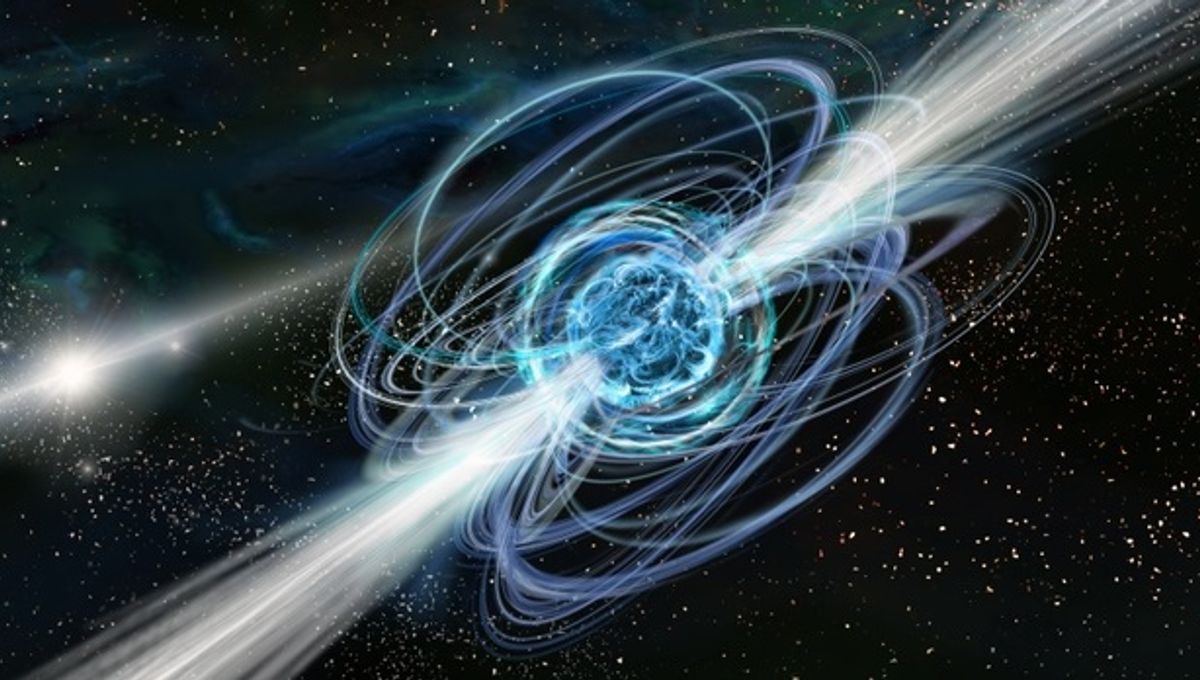
Evidence has been found for the previously speculative idea that Fast Radio Bursts (FRBs) are caused by neutron stars having a sort of earthquake. The same work also throws doubt on one alternative explanation, that they are caused by stellar flares. If the connection is confirmed, it could not only tell us more about the behavior of matter under unimaginable pressure, but something about earthly quakes.
Sixteen years ago, a new phenomenon was detected in archival data from the Murriyang radio telescope: a very short radio pulse whose origin could not be identified. Now that we know what to look for, we’ve learned there are thousands of these FRBs occurring every day, which only makes astronomers more anxious to understand their causes.
While overshadowed by other transient phenomena like supernovas or gamma ray bursts, a typical FRB still releases more energy in milliseconds than the Sun does in several days. Clearly only something immensely powerful could be causing these events, making a mockery of those who resolutely insist it’s aliens.
Moreover, while most FRBs appear to be one-and-dones, a few repeating sources have been identified. There aren’t many objects in the universe powerful enough to release even one FRB, let alone several, and neutron stars are an obvious candidate, particularly the highly magnetized subcategory known as magnetars.
However, just blaming neutron stars doesn’t explain how they could produce FRBs. “It was theoretically considered that the surface of a magnetar could be experiencing a starquake, an energy release similar to earthquakes on Earth,” said Professor Tomonori Totani of the University of Tokyo in a statement.
There wasn’t a lot of evidence for this idea, besides it being one of the few mechanisms astronomers could imagine. However, with the number of FRB detections having risen into the thousands, Totani and graduate student Yuya Tsuzuki took the opportunity to seek patterns they could compare with hypothesized causes.
Other scientists attempting to find patterns in the FRB data have looked at the wait times between bursts for repeating FRBs. Totani and Tsuzuki also looked at the relationships between how energetic bursts were and those that followed them. Just three frequently repeating FRBs gave them a sample of nearly 7,000 to work with.
Rather than being random, the pattern of large versus small bursts looks a lot like earthquake data, but not at all like solar flares. The latter is important, because the possibility FRBs could be associated with flares of extremely powerful stars has also been considered.
“The probability of an aftershock occurring for a single event is 10-50 percent,” Totani said. “The aftershock occurrence rate decreases with time, as a power of time; […] the aftershock rate is always constant even if the FRB-earthquake activity (mean rate) changes significantly; [and] there is no correlation between the energies of the main shock and its aftershock.”
All of these are familiar patterns to seismologists. As you might expect considering the number of lives on the line, Japanese scientists have done plenty of analysis on the ways earthquakes there relate to each other. Totani and Tsuzuki note the similarity of what they found to seismic data from five provinces of Japan. On the other hand, these FRB relationships don’t look at all like the relationships between solar flares.
Totoni and Tsuzuki see their findings as evidence that at least some neutron stars have solid crusts enveloping their superdense interiors. They think movements of the crust, such as pieces scraping past each other, can release bursts of energy we can detect as FRBs and these movements may be driven by the gravitational forces created by close approaches to companion stars.
With a sample of just three repeating FRBs the pair don’t know if what they are seeing is indicative of how all FRBs occur, or only an unrepresentative minority.
“Starquakes in neutron stars have opened up the possibility of gaining new insights into very high-density matter and the fundamental laws of nuclear physics,” Totani said. Attractive as this is to theoretical physicists, the pair also hope it will improve our understanding of earthquakes, and therefore our ability to predict when they will strike.
The study is published open access in Monthly Notices of the Royal Astronomical Society.
Source Link: “Starquakes” On Neutron Stars Could Be Source Of Mysterious Fast Radio Bursts